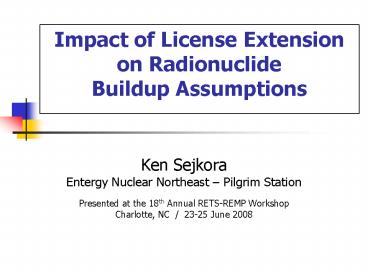Ken Sejkora - PowerPoint PPT Presentation
1 / 17
Title:
Ken Sejkora
Description:
Impact of License Extension on Radionuclide Buildup Assumptions Ken Sejkora Entergy Nuclear Northeast Pilgrim Station Presented at the 18th Annual RETS-REMP Workshop – PowerPoint PPT presentation
Number of Views:93
Avg rating:3.0/5.0
Title: Ken Sejkora
1
- Ken Sejkora
- Entergy Nuclear Northeast Pilgrim Station
- Presented at the 18th Annual RETS-REMP Workshop
- Charlotte, NC / 23-25 June 2008
2
Reason for Concern
- Regulatory Guide 1.109 accounts for buildup of
radioactivity for the following exposure
pathways - Waterborne Nuclides in Shoreline Deposits
- Waterborne Nuclides in Irrigated Foods
- Deposition of Airborne Nuclides on Ground Plane
- Deposition of Airborne Nuclides on Soil and
Crops forage, produce, vegetables, milk, meat
3
Reason for Concern (continued)
- Regulatory Guide 1.109 assumes buildup period
(tb) of 15 years - approximate midpoint of facility operating
life per Equations A-4 and C-1 - Many facilities have operated for well beyond 15
years, and many are pursuing license extension
for an additional 20 years of operation total
span of up to 60 years
4
Reason for Concern (continued)
- What is the impact on dose calculations of
assuming buildup during entire duration of
40-year license? - What is the impact on dose calculations of
assuming 20 years of additional operation?
5
Buildup Equation
- Used in RG-1.109 equations 3, 4, A-4, A-6, A-7,
A-8, A-13, C-1, and C-5 - General form of equation
Where ?i nuclide decay constant, yr -1
tb buildup period, yr
6
Buildup Factor by Nuclide
Nuclide Half-life years Lambda Buildup Factor by Buildup Period Buildup Factor by Buildup Period Buildup Factor by Buildup Period
Nuclide Half-life years Lambda 15-yr 40-yr 60-yr
Mn-54 0.856 8.10E-01 1.24E00 1.24E00 1.24E00
Fe-59 0.122 5.67E00 1.76E-01 1.76E-01 1.76E-01
Co-60 5.271 1.32E-01 6.55E00 7.56E00 7.60E00
Zn-65 0.669 1.04E00 9.65E-01 9.65E-01 9.65E-01
Sr-90 28.600 2.42E-02 1.26E01 2.56E01 3.16E01
I-131 0.022 3.15E01 3.18E-02 3.18E-02 3.18E-02
Cs-134 2.062 3.36E-01 2.96E00 2.97E00 2.97E00
Cs-137 30.170 2.30E-02 1.27E01 2.62E01 3.26E01
7
Buildup Factor Ratio by Nuclide
Nuclide Ratio to 15-yr Buildup Factor Ratio to 15-yr Buildup Factor Ratio to 15-yr Buildup Factor
Nuclide 15-yr 40-yr 60-yr
Mn-54 1.00 1.00 1.00
Fe-59 1.00 1.00 1.00
Co-60 1.00 1.16 1.16
Zn-65 1.00 1.00 1.00
Sr-90 1.00 2.04 2.51
I-131 1.00 1.00 1.00
Cs-134 1.00 1.01 1.01
Cs-137 1.00 2.06 2.57
8
Clarification of Buildup Equation for Vegetation
Pathways
Equation for Buildup in Vegetation
External Surface Contamination Term Short-term
weathering
Internal Plant-Soil Uptake Term Long-term
metabolism
Affects equations for irrigated crops, produce,
vegetables, and forage (which in turn affects
milk and meat)
9
Vegetation External Contamination Term
Where r fraction of deposited activity
retained on leaf/plant surface ?Ei
weathering removal rate constant, 14-day
half-life nuclide half-life te exposure
time to deposition fallout forage 30d, crops
60d Yv vegetation yield forage 0.7 kg/m2,
crops 2 kg/m2 The external contamination term
from deposition fallout typically accounts for 75
to 100 of the total radionuclide activity in and
on vegetation. Not dependent on duration of
buildup period.
10
Vegetation Internal Plant-Soil Uptake Term
Where fI fraction of year forage/crops are
growing or irrigated (exposed) Biv
soil-to-plant uptake factor for nuclide i P
effective surface soil density, 240 kg/m2 The
metabolic uptake term from soil typically
accounts for less than 10 of the total
radionuclide activity in and on forage (cow-milk
pathway), and less than 20 in the crop pathway.
11
Forage Concentration Terms
Nuclide Deposition Term Uptake Term Uptake Term Uptake Term
Nuclide Deposition Term 15-yr 40-yr 60-yr
Mn-54 1.04E02 1.31E00 1.31E00 1.31E00
Fe-59 9.04E01 4.25E-03 4.25E-03 4.25E-03
Co-60 1.07E02 2.25E00 2.60E00 2.61E00
Zn-65 1.04E02 1.41E01 1.41E01 1.41E01
Sr-90 1.07E02 7.80E00 1.59E01 1.96E01
I-131 2.48E02 2.32E-02 2.32E-02 2.32E-02
Cs-134 1.06E02 1.08E00 1.09E00 1.09E00
Cs-137 1.07E02 4.63E00 9.55E00 1.19E01
12
Forage ConcentrationBuildup Factor Ratio by
Nuclide
Nuclide Ratio to 15-yr Buildup Factor Ratio to 15-yr Buildup Factor Ratio to 15-yr Buildup Factor
Nuclide 15-yr 40-yr 60-yr
Mn-54 1.00 1.00 1.00
Fe-59 1.00 1.00 1.00
Co-60 1.00 1.00 1.00
Zn-65 1.00 1.00 1.00
Sr-90 1.00 1.07 1.10
I-131 1.00 1.00 1.00
Cs-134 1.00 1.00 1.00
Cs-137 1.00 1.04 1.06
13
Crop Concentration Terms
Nuclide Deposition Term Uptake Term Uptake Term Uptake Term
Nuclide Deposition Term 15-yr 40-yr 60-yr
Mn-54 4.43E01 1.31E00 1.31E00 1.31E00
Fe-59 3.61E01 4.25E-03 4.25E-03 4.25E-03
Co-60 4.57E01 2.25E00 2.60E00 2.61E00
Zn-65 4.39E01 1.41E01 1.41E01 1.41E01
Sr-90 4.59E01 7.80E00 1.59E01 1.96E01
I-131 8.84E01 2.32E-02 2.32E-02 2.32E-02
Cs-134 4.53E01 1.08E00 1.09E00 1.09E00
Cs-137 4.59E01 4.63E00 9.55E00 1.19E01
14
Crop ConcentrationBuildup Factor Ratio by Nuclide
Nuclide Ratio to 15-yr Buildup Factor Ratio to 15-yr Buildup Factor Ratio to 15-yr Buildup Factor
Nuclide 15-yr 40-yr 60-yr
Mn-54 1.00 1.00 1.00
Fe-59 1.00 1.00 1.00
Co-60 1.00 1.01 1.01
Zn-65 1.00 1.00 1.00
Sr-90 1.00 1.15 1.22
I-131 1.00 1.00 1.00
Cs-134 1.00 1.00 1.00
Cs-137 1.00 1.10 1.14
15
Summary
- Extended buildup period has negligible impact on
ingestion pathway concentrations and doses from
irrigated crops, produce, vegetables, milk, and
meat less than 25 increase for worst-case
nuclide (Sr-90) for 60-year buildup period most
nuclides exhibit lt1 increase
16
Summary (continued)
- Ground plane or sediment exposure can be affected
up to 2-times the 15-year assumption, but these
exposure pathways typically contribute less than
0.05 of the total dose - Buildup equations assume uniform release rates
(Ci/yr) over duration of buildup period. Current
and future release rates are likely much lower
than those when plants began operation
17
Conclusion
- Increased buildup time posed by license extension
carries negligible impact for affecting effluent
dose calculations. - There is no need to modify RG-1.109 equations or
buildup assumptions to account for additional
buildup from additional years of operation.





![READ [PDF] Ken Uston on Blackjack PowerPoint PPT Presentation](https://s3.amazonaws.com/images.powershow.com/10107824.th0.jpg?_=20240825013)


![[PDF] DOWNLOAD Million Dollar Blackjack by Ken Uston (1998-0 PowerPoint PPT Presentation](https://s3.amazonaws.com/images.powershow.com/10106628.th0.jpg?_=20240824053)




![[PDF] DOWNLOAD The Dow of Master Ken: Vol. 1: By 11th Degree Black Bel PowerPoint PPT Presentation](https://s3.amazonaws.com/images.powershow.com/10058302.th0.jpg?_=20240619032)

![READ [PDF] Phallic Frenzy: Ken Russell and His Films PowerPoint PPT Presentation](https://s3.amazonaws.com/images.powershow.com/10071629.th0.jpg?_=20240703019)















